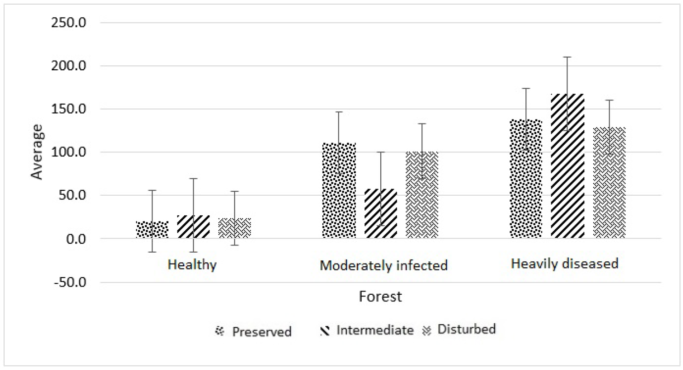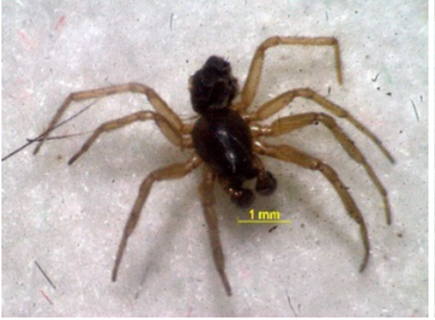Serviços Personalizados
Journal
Artigo
Indicadores
-
 Citado por SciELO
Citado por SciELO -
 Acessos
Acessos
Links relacionados
-
 Similares em
SciELO
Similares em
SciELO
Compartilhar
Revista mexicana de ciencias forestales
versão impressa ISSN 2007-1132
Rev. mex. de cienc. forestales vol.10 no.53 México Mai./Jun. 2019
https://doi.org/10.29298/rmcf.v10i53.480
Articles
Phytosanitary characterizaction of Quercus obtusata Bonpl., in a mountain cloud forest, Xicotepec, Puebla
1Laboratorio de Biología de la Conservación, Departamento de Ciencias Ambientales, CBS, Universidad Autónoma Metropolitana Unidad Lerma. México.
Cloud forests (CF) are part of the great diversity of plant communities in Mexico, covering around 10 % of the diversity that exists only in 5 % of the territory. Quercus is one of the most representative and abundant tree genera in montane cloud forests, and it is important because of the ecosystemic services that it provides. Despite its importance, few studies have focused on the phytosanitary status of this genus in CFs. The present study determines the types of pathogenic organisms affecting the phytosanitary status of Quercus obtusata, which is endemic to Mexico. In 2017, a quota sampling was carried out in three sites with different conservation degrees during the rainy and the dry seasons. The height and the diameter at breast height of each tree were measured; three branches were collected from each individual in order to analyze the organisms present on the leaves― and classified according to a scale of damage. The correspondence analysis evidenced a significant association (x2 p<0.001) between the variables sites and scale of damage, i.e. between the disturbed and intermediate sites and the more severe degrees of infection. During the dry season, the three sites exhibited a larger number of infected leaves. Mainly two types of gallwasps belonging to the genera Andricus and Kinseyella of the Cynipidae family were obtained, as well as various types of arthropods and defoliators.
Key words: Galls; mountain cloud forest; Cynipidae; oak; forest health; Quercus obtusata Bonpl
Los Bosques Mesófilos de Montaña (BMM) son parte de la gran diversidad de comunidades vegetales que se desarrollan en México, albergan cerca de 10 % de la diversidad existente en el país, en 5 % del territorio nacional. Dentro de los BMM, Quercus es uno de los géneros arbóreos más representativos, abundantes e importantes por los servicios ecosistémicos que proporciona. A pesar de su importancia, se han realizado pocos estudios enfocados en conocer su estado fitosanitario en BMM. En el 2017, se realizó un muestreo por cuotas, en las temporadas seca y de lluvias, en tres sitios con dicho tipo de vegetación y diferente grado de conservación: perturbado, intermedio y conservado. Se midió la altura del árbol, el diámetro a la altura del pecho y se recolectaron tres ramas por individuo para analizar los organismos existentes en las hojas, las cuales se contaron y clasificaron con una escala de daño. El análisis de correspondencia mostró que las variables bosque y grados de infección están significativamente asociadas (x2 p<0.001), de tal forma que los bosques perturbado e intermedio están asociados a los grados más altos de infección. Durante la época de sequía, los tres bosques evidencian un mayor número de hojas infectadas. Se obtuvieron principalmente dos tipos de insectos agallícolas pertenecientes a la Familia Cynipidae de los géneros Andricus y Kinseyella, así como diversos tipos de artrópodos y defoliadores.
Palabras clave: Agallas; Bosque mesófilo de montaña; Cynipidae; encino; fitosanidad; Quercus obtusata Bonpl
Introduction
Cloud forests (CF) are part of the great diversity of vegetal communities that grow in Mexico (Gual-Díaz and Rendón-Correa, 2014). 2 500 species of vascular plants are estimated to exist. They belong to 650 genera, grouped into 144 families, and live preferentially in this type of vegetation: they amount to approximately 10 % of the floristic wealth of the country and constitute the most diverse vegetal community per surface area unit in the territory of the Mexican Republic (Rzedowski, 1991, 1996). However, today this important ecosystem covers only 54.7 % of its original distribution (Gual-Díaz and Rendón-Correa, 2014).
Quercus is one of the most characteristic and important taxa in Mexico; it comprises approximately 161 species, of which 107 are endemic (Sosa-Ramírez et al., 2011), and the CFs alone are estimated to contain a wealth of 37 taxa (González-Espinosa et al., 2012).
The importance of the genus Quercus in the CFs was analyzed in recent years, and it was concluded that they are largely dominant in their communities; this allows them to have a greater diversity than other species and, therefore, they play a crucial role in the ecosystem (Juárez-Medina, 2013). Despite the diversity of the Quercus in Mexico, there are few studies about their diseases, and those that are available are focused on the perspective of forest exploitation, leaving aside the role of biological host/parasite interactions (Valencia-A., 2004).
A high mortality of oaks was observed during the last decade in the states of Aguascalientes, Colima, Guanajuato, Jalisco and Nayarit, due to pests and diseases, whose main causal agents were phytopathogenic fungi, borer insects and mistletoe (Sosa-Ramírez et al., 2011). These organisms affect the health of Quercus spp. individuals, rendering them susceptible of being infected by opportunistic organisms (Romo et al., 2007). There is only one phytosanitary investigation for Quercus obtusata Bonpl., in which the fungus Hypoxylon sp. was cited. This study was conducted in the Sierra Fría, Aguascalientes (Romo et al., 2007).
Forest tree diseases due to pathogens are estimated to be the third cause of damage, affecting over 2 million m3 of wood and generating losses of 50 to 100 % of its commercial value (Alvarado-Rosales et al., 2007; Conafor, 2018).
Xicotepec de Juárez municipality, Puebla state, has historically been one of the largest producers of coffee in Mexico (Evangelista et al., 2010; FIRA, 2016). This has favored the conversion of the CFs into coffee plantations, as these agroecosystems establish themselves beneath the shade of the original vegetation. Thus, the CF in this municipality is in a critical state of conservation due to the high rate of land use change (Ruiz et al., 2005). In addition, it is one of the regions where the presence of Quercus obtusata has been recorded. For this reason, in the face of the abovementioned modification in the CF, the assessment of the phytosanitary status of Quercus obtusata and the identification of the pathogens which attack it in the remaining forests of Xicotepec de Juárez was proposed, in order to generate the knowledge that contributes to decision making in regard to the management and conservation of this oak species in the region.
Materials and Methods
Study area
The study was carried out at the Las Cañadas ranch (20°18'49.35" N, 98°0'48.57" W) and its surroundings, on a surface area of 80 ha, and at an altitude interval of 800 to 1 050 m, within the Xicotepec de Juárez municipality, in the state of Puebla. The final selected area corresponded to 11.34 ha distributed in three sites.
According to the data of the climate station of the National Weather Service No. 0002117, in Xicotepec de Juárez, for the period, the mean annual temperature in the area is 18.6 °C, and the annual precipitation adds up to 3 181.5 mm (Conagua-SMN, 2010).
Sampling sites
Vegetation patches that may correspond to the CF within the municipality were identified using the ArcGis 10.5 (ESRIl, 2010) and Google Earth softwares, with their satellite imagery and through the processing of the Land Use and Vegetation Layer, Series V, Scale 1:250 000 (Inegi, 2015). Based on this, from June 2016 to December 2017, five rounds were carried out in the patches in order to verify sites with the presence of CFs, considering three criteria: a) forests without coffee plantations, forests with evidence of natural disturbances (forest fires), forests with anthropogenic intervention (agricultural or livestock activities, or some degree of management, such as fellings); b) accessibility to plots with the corresponding permissions by the owners for the present study; c) CFs with of Quercus obtusata trees.
After these rounds, most of the patches were discarded, including those classified as primary vegetation by the Land Use and Vegetation Layer of series V because they all exhibited coffee plantations, as the presence of coffee plants significantly alters the structural characteristics and the dynamics of the vegetation by favoring the dominance of certain species (Ruiz et al., 2005). Based on the evidence of forest fires and of anthropogenic intervention, remnants of CFs with the presence of Quercus obtusata were selected within the Las Cañadas ranch and in nearby areas (Figure 1).
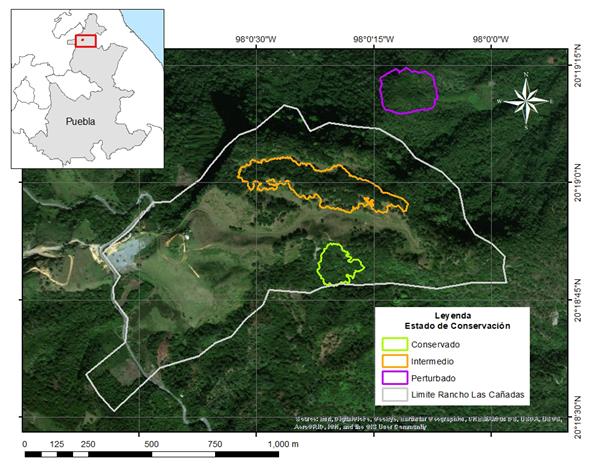
Leyenda = Leyend; Estado de conservación = State of conservation; Conservado = Preserved; Intermedio = Intermediate; Perturbado = Disturbed; Límite Rancho Las Cabañas = Las Cañadas ranch limit.
Figure 1 Location of the different types of forest: preserved, intermediate and disturbed.
Three conditions of forests were located and differentiated in the field according to the following characteristics:
Preserved forest (PF)
It is characterized by the absence of forest fires. Vegetation exhibits a complex structure, vegetation horizontal strata consist of tree layers: trees, shrubs, and herbs. It is the only site with a great abundance and diversity of epiphytes belonging to the Orchidaceae and Bromeliaceae families; as well as of arborescent ferns, a characteristic element of the CFs, and oak seedlings. No anthropic evidences were observed in the site.
Intermediate forests (IF)
Absence of forest fires and signs of grazing activities that ceased about 5 years ago. The shrub layer is missing. There is a minimal number of holm oak seedlings, as well as of epiphytes, which, in any case, belong exclusively to the Bromeliaceae family.
Disturbed forest (DF)
It is characterized by the evidence of forest fires, which can be perceived in the presence of charcoal in the bark of all the Quercus obtusata trees, which can reach 1.5 m, as well as of carbonized stumps. There is no defined shrub layer; a high density of shrubs is prevalent; some of the shrubs belong to the Asclepiadaceae family. No epiphytes or oak seedlings are observed. The forest fire occurred around four years ago.
Samplings were carried out during the dry season, characterized by scarce rainfalls during the period from December to April, when a mere 322.7 mm were accumulated, in contrast to the 2 858.8 mm of rainfall that corresponded to the rainy season, from May to November (Conagua-SMN, 2010).
A quota sampling was carried out during both seasons, with the selection of 11 Quercus obtusata trees, which were marked and labeled in each of the three forest types (preserved, intermediate, and disturbed). Samples of a total of 33 individuals were obtained during each season. The of each tree were measured with a Haglöf ECII D-R digital clinometer and the diameter at breast height (DBH) with a Forestry Suppliers Inc Jackson MS diametric tape, and three branches with an approximate length of 60 cm were collected from each individual at a height of 5 to 10 m, in different directions with respect to the north (0°, 120° y 240°), in order to make a record of the organisms existing in the branches and leaves.
All the leaves were removed and classified according to their degree of infection, based on the classification by Romo et al. (2007), which considers three degrees of infection (Table 1).
Table 1 Degrees of infection in Quercus obtusata Bonpl. leaves, based on the classification by Romo Díaz et al. (2007).
The identification of the pathogenic organisms was corroborated with specialists of the Colegio de Postgraduados (Graduate Studies College), Montecillo campus, and of the Laboratorio de Análisis y Referencia en Sanidad Forestal (LARSF), Dirección General de Gestión Forestal y de Suelos, Semarnat.(Forest Health Analysis and Reference Laboratory (LARSF) of the General Direction of Forest and Soil Management, Semarnat).
Statistical analysis
In order to describe the characteristics of the sampled trees in each forest type, the average diameters at breast height (DBH) and height with their respective standard error.
Total infection was calculated based on the summation of the leaves belonging to the various degrees of infection, by forest type and by season (Romo et al., 2007), and in order to corroborate the accuracy of this classification of the data, their correspondence with the degrees of infection was analyzed. Likewise, in order to determine the existence of a significant association between the variables site, degrees of infection and sampling seasons, an independence test based on the statistic X2 was carried out and later corroborated by means of a correspondence analysis. The statistic software SAS JMP (v12.0) was used (SAS Institute, 2018).
Results and Discussion
The average heights and DBHs of the Q. obtusata population in the various
forest types ―Preserved (height

Figure 2 Comparison between the average heights of Quercus obtusata Bonpl. in the three types of forests.

Figure 3 Comparison between the average diameters of Quercus obtusata Bonpl. in the three types of forests.
As for the averages of the number of infected leaves per tree in each forest type and season,
the estimates were as follows: healthy
The analysis of discriminants carried out to validate the classification of the different phytosanitary statuses exhibited a consistency of 89.3 % (p<0.001), and shows that, out of the 33 individuals analyzed and resampled in each season (dry and rainy), only a total of seven, considering both seasons, were wrongly classified. However, this information was verified in the original matrix, and a minimal difference between the classifications was observed. Therefore, it was concluded that the software may be reclassifying them because their values are very close to the interval of the next category.
Figure 6 depicts the observations as points, and the mean as the symbol +, while the ellipse around the mean corresponds to the confidence interval (95 %). If the ellipses do not cross, in which case the groups differ significantly, the second ellipse contains approximately 50 % of the observations and assumes normality. The graph shows a good classification of the individual in each of the categories.
Canonical graph

Gráfico canónico = Canonical graph; Clasificación = Clasification; Enfermo = Heavily diseased; Inter = Moderately Infected Sano = Healthy.
Figure 6 Association between variables: degrees of infection and provided classifications.
The second analysis grouped forest types and degrees of infection, in which the association between the variables turned out to be significant, according to the independence test based on the statistic x2 (x2 p<0.001); thus, the disturbed and intermediate forests area related to the highest degrees of infection, in contrast to the healthy forests associated to the preserved site, remains distant from the other degrees (Figure 7).

Conservada = Preserved; Inter = Intermediate; Perturbada = Disturbed; Bosque = Forest; Grados de infección = Degrees of infection
Figure 7 Correspondence analysis showing the relationship between the forest types and the degrees of infection.
Subsequently, a correspondence analysis was made adding temporality; in the case of the dry season, an association was observed between the preserved and disturbed forests, unlike the intermediate site, which exhibited a greater association with the diseased forests (x2 p<0.001) (Figure 8).
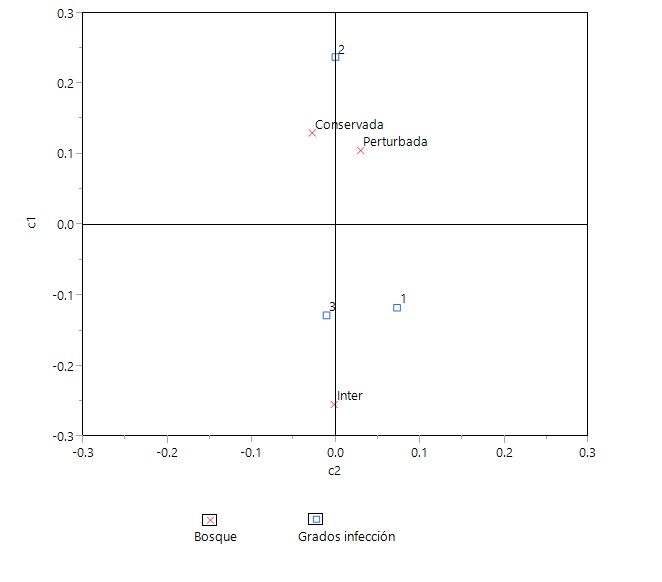
Conservada = Preserved; Inter = Intermediate; Perturbada = Disturbed; Bosque = Forest; Grados de infección = Degrees of infection.
Figure 8 Corresponding analysis of the dry seasons by forest type and degree of infection.
During the rainy season, the intermediate and disturbed forests exhibited associations with the moderately infected and heavily diseased leaves, respectively, while the preserved forest was associated to healthy leaves; thus, the association between the various degrees of infection and forest types is very evident (x2 p<0.001) (Figure 9).
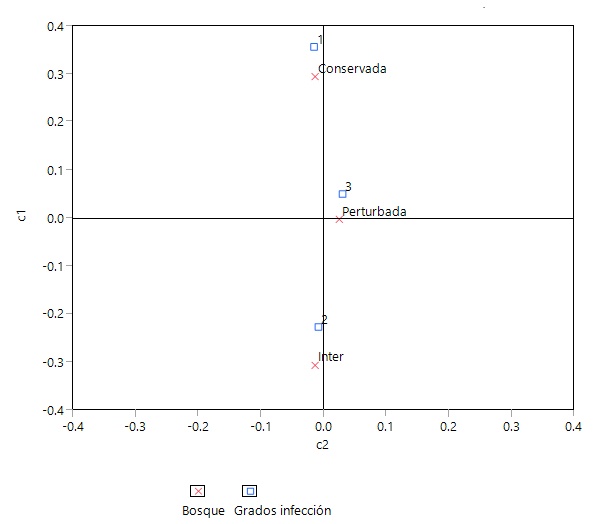
Conservada = Preserved; Inter = Intermediate; Perturbada = Disturbed; Bosque = Forest; Grados de infección = Degrees of infection.
Figure 9 Correspondence analysis of between forest types and degrees of infection during the rainy season.
The analysis of leaf samples showed that the main pathogen in Quercus obtusata were the gallwasps belonging to the Andricus and Kinseyella genera of the Cynipidae family. In addition, other species of insects and arthropods that reutilize dry galls as shelters were identified and classified as proposed by Pujade-Villar (2013, Table 2). According to the results, the intermediate forest was the one that exhibited the highest degree of herbivory and the largest amount of viruses and galls ―an evidence that these are more frequent during the dry season.
Table 2 Pathogenic and opportunistic insects and arachnids found in the samples leaves of Quercus obtusata Bonpl.
The gallwasps (Cynipidae) that were found have the ability to induce the formation of galls, as well as larvae (Pujade-Villar, 2013). Although Cynipidae species do not exhibit a negative interaction with their hosts. Pujade-Villar (2013) mentions that a population explosion of these insects can become potentially harmful as is the case of the genus Andricus, which have the ability to cause damage to the branches of various Quercus taxa and the death of the oak tree (Pujade-Villar, 2013). On the other hand, Hoover (2004) mentions that gall-inducing insects are also reported to cause little or no effect on the health of the trees. However, certain studies reveal fatal effects of galls on oak groves, as in the case of Q. laurina Bonpl. and Q. affinis M.Martens & Galeotti, in the state of Hidalgo, which are under attack by Andricus quercuslaurinus Melika & Pujade-Villar; this has resulted in a change in the ecosystem, as these trees are being displaced by other oak and pine species (Pujade-Villar, 2013).
The statistical analyses evidenced a predominance of the sick status for all forest types. Nevertheless, the correspondence analysis exhibited a greater association between this infection degree and intermediate and disturbed forests than with well-preserved forests. This shows that forests that have had any kind of disturbance are more vulnerable to attack by pathogenic organisms. As Romo et al. (2007) point out, the decline of holm oaks is not due to a sole pathogenic agent but to various factors that damage the health of these trees, rendering them susceptible to attacks by pathogenic or opportunistic agents. Prominent among these are gallwasps, which can develop in different parts of the tree, such as the stem, the branches or the leaves (Pujade-Villar et al., 2010).
Pujade-Villar (2013) defines galls as abnormal structures of parts of plant tissues and organs that are produced due to the activity of an inductor organism, which in turn is considered to be a vegetal cancer.
Claudio-García and Jaime-Granados (2005) explain that foliar diseases such as stains damage the photosynthetic system by causing a reduction of photosynthesis and an increase in the breath rate; consequently, the plant is starved of reserve substances and its growth is reduced, and therefore it dies. It is also possible to observe damage in the diffusion of CO2 and in the stomatal opening; therefore, individuals increase their water consumption, which causes hydric stress to the plant. Hydric stress and low temperature are regarded as factors that increase the decline and death of oaks (Alvarado-Rosales et al., 2007). This phenomenon can originate in the dry season; therefore, there were more individuals with moderate and severe infection degrees than during the rainy season.
There are few studies on the ecology and the agents related to the decline of Quercus obtusata, which is a cause of worry, as it is a long-living endemic species of Mexico; therefore, it should be a priority to generate scientific knowledge of the ecological aspects that contribute to its preservation.
Conclusions
Temporality and seasonality are important factors in the determination of infection degrees, since, in most individuals, damage at any level occurs during the dry season and virtually in all forest types.
As for the pathogenic agents, they are primarily gallwasps, which, according to the literature, cannot affect oak populations seriously. Nevertheless, the lack of good control causes major forest losses.
MCF management and preservation must be a priority in the Quercus obtusata populations of the Xicotepec municipality, Puebla, due to the scarce distribution of this species in the country and its high vulnerability and endangerment.
This study provides several elements to start research lines on the phytosanitary status of the Cloud Forest and highlights the importance of developing and promoting mitigation strategies and actions in these ecosystems.
Acknowledgements
The authors wish to express their gratitude for the support provided by the Universidad Autónoma Metropolitana (Autonomous Metropolitan University), Lerma campus, for the development of the study ―a product of the social service that is part of the research project “Ecology, Management and Conservation of the Montane Cloud Forest in Puebla”. To Elías Aparicio Monroy for his hospitality and for the facilities granted for the field work within the Las Cañadas ranch. To Uriel Barrera, MSc, for his help in the field and for the identification of the genus of the gallwasps, and to Engineer Oscar Trejo and Eduardo Jiménez, PhD, for the facilities granted for the identification of specimens at the Forest Health Analysis and Reference Laboratory of Semarnat.
REFERENCES
Alvarado-Rosales, D., L. d. L., Saavedra-Romero, A. Almaraz-Sánchez, B. Tlapal-Bolaños, O. Trejo-Ramírez, J. M. Davidson y D. Quiroz-Reygadas. 2007. Agentes asociados y su papel en la declinación y muerte de encinos (Quercus, Fagaceae) en el Centro-Oeste de México. Polibotánica 23: 1-21. [ Links ]
Claudio-García, L. E. y R. Jaime-Granados. 2005. Evaluación de enfermedades y plagas en pinos y encinos del Bosque "La Primavera", Jalisco. In: Foro de Investigación y Conservación del Bosque la Primavera. Zapopan, JAL., México. pp- 16-17. [ Links ]
Comisión Nacional Forestal (Conafor). 2018. Programas Específicos de Intervención Institucional. México, D.F., México. pp. 6-7. [ Links ]
Comisión Nacional del Agua- Sistema Meteorológico Nacional (Conagua-SMN). 2010. Red de Estaciones Climatológicas. México. Comisión Nacional del Agua y Servicio Meteorológico Nacional. https://smn.cna.gob.mx/es/climatologia/informacion-climatologica/informacion-estadistica-climatologica (10 de marzo de 2019). [ Links ]
Environmental Systems Research Institute (ESRI). 2010. ArcGIS Desktop. Release 10. Redlands, CA USA. n/p. [ Links ]
Fideicomisos Instituidos en Relación con la Agricultura (FIRA). 2016. Panorama Agroalimentario: Café 2016. Fideicomisos Instituidos en Relación con la Agricultura. Dirección de Investigación y Evaluación Económica y Sectorial. México, D.F., México. 37 p. [ Links ]
González-Espinosa, M., J. A. Meave, N. Ramírez-Marcial, T. Toledo-Aceves, F. G. Lorea-Hernández y G. Ibarra-Manríquez. 2012. Los bosques de niebla de México: conservación y restauración de su componente arbóreo. Ecosistemas 21: 36-52. [ Links ]
Gual-Díaz, M. y A. Rendón-Correa. 2014. Bosques Mesófilos de Montaña de México: diversidad, ecología y manejo. Comisión Nacional para el Conocimiento y Uso de la Biodiversidad. México, D.F., México. 352 p. [ Links ]
Hoover, G. 2004. Agallas en el Roble. http://ento.psu.edu/extension/factsheets/es/es-galls-on-oak (15 de diciembre de 2018). [ Links ]
Instituto Nacional de Estadística y Geografía. (Inegi). 2015. Conjunto de datos vectoriales de la carta de uso del suelo y vegetación: escala 1:250 000. Serie V (Continuo Nacional). Inegi. Aguascalientes, Ags., México. https://www.inegi.org.mx/temas/mapas/usosuelo/ (10 de marzo de 2019). [ Links ]
SAS Institute. 2018. SAS JMP®. Version 12.0. SAS Institute Inc. Cary, NC USA. n/p. [ Links ]
Juárez-Medina, A. K. 2013. Diversidad alfa y beta de tres bosques mesófilos de montaña de México ubicados en diferentes provincias biogeográficas. Maestría en Ciencias Biológicas. Facultad de Estudios Superiores Iztacala, UNAM. México, D.F., México. 58 p. [ Links ]
Pujade-Villar, J. 2013. Las agallas de los encinos: un ecosistema en miniatura que hace posible estudios multidisciplinares. Entomología Mexicana 21(1): 2-22. [ Links ]
Pujade-Villar, J., S. Romero-Rangel, C. Chagoyán-García, A. Equihua-Martínez, E. G. Estrada-Venegas and G. Melika. 2010. A new genus of oak gallwasps, Kinseyella Pujade-Villar y Melika, with a description of a new species from México (Hymenoptera: Cynipidae: Cynipini). Zootaxa 2335(1):16-28. [ Links ]
Romo D., B., R. Velásquez V., M. E. Siqueiros D., G. Sánchez M., M. de la Cerda L., M., O. Moreno R. y E. Pérez M. B. 2007. Organismos con efecto potencial en el declinamiento de encinos de la Sierra Fría, Aguascalientes, México. Investigación y Ciencia 15(39):11-18. [ Links ]
Ruiz, J., M. Riverol, V. Tamaríz y R. Castelán. 2005. Zonificación agroecológica de la Sierra Norte de Puebla. Benemérita Universidad Autónoma de Puebla. Puebla, Pue., México. 188 p. [ Links ]
Rzedowski, J. 1991. Diversidad y orígenes de la flora fanerogámica de México. Acta Botánica Mexicana 14: 3-21. [ Links ]
Rzedowski, J. 1996. Análisis preliminar de la flora vascular de los bosques mesófilos de montaña de México. Acta Botánica Mexicana 35:25-44. [ Links ]
Sosa-Ramírez, J., O. Moreno-Rico, G. Sánchez-Martínez, M. E. Siqueiros-Delgado y V. Díaz-Nuñez. 2011. Ecología y fitosanidad de los encinos (Quercus spp). en la Sierra Fría, Aguascalientes, México. Madera y Bosques 17: 49-63 [ Links ]
Valencia-A., S. 2004. Diversidad del género Quercus (Fagaceae) en México. Boletín de la Sociedad Botánica de México 75: 33-53. [ Links ]
Received: December 10, 2018; Accepted: March 19, 2019











 texto em
texto em 




